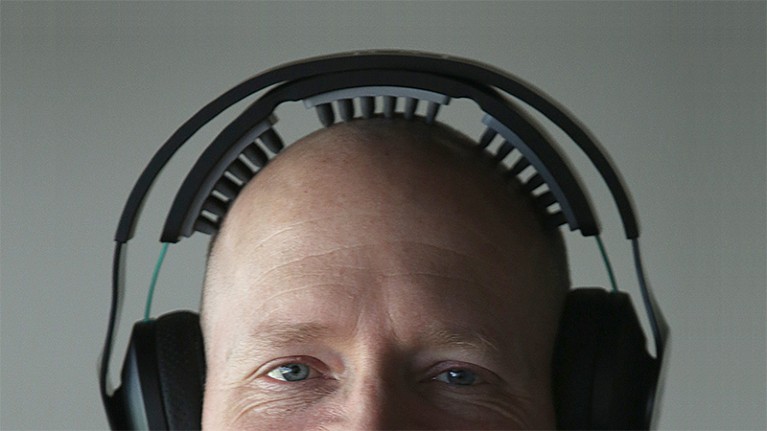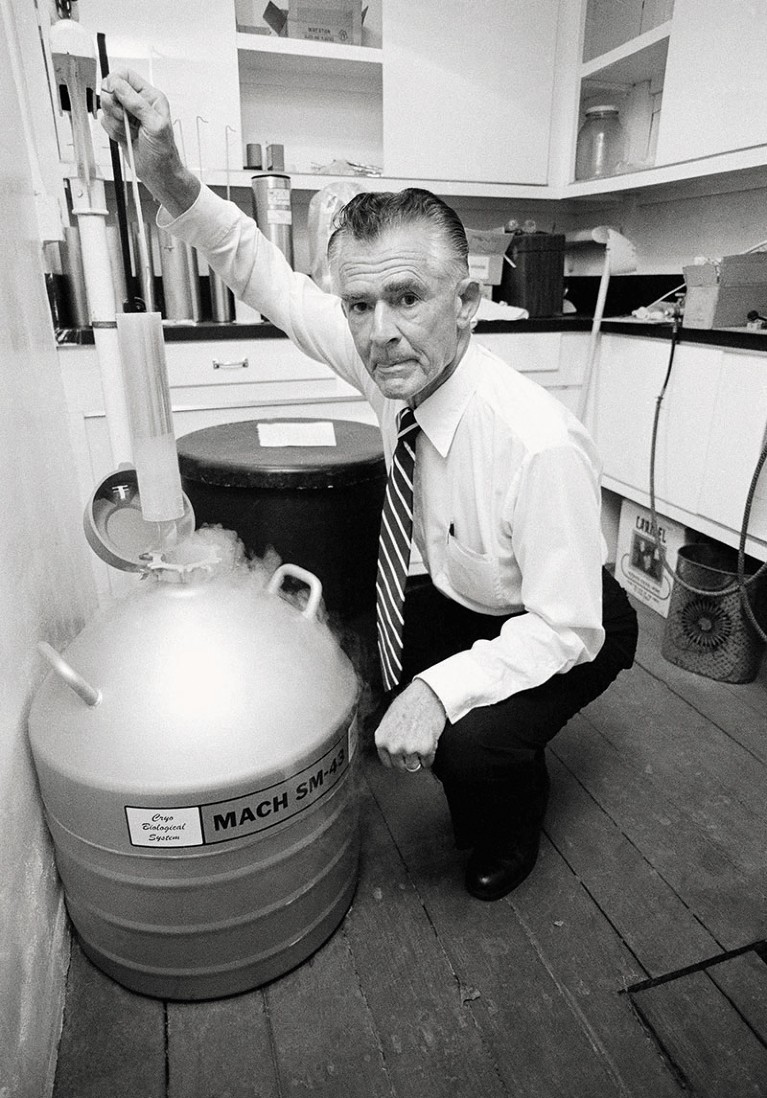
Transcranial direct current stimulation has been claimed to enhance learning.Credit: Liz Hafalia/Polaris/eyevine
The Genius Within: Unlocking Your Brain’s Potential David Adam Pegasus: 2018.
Is there a common element that binds diverse mental abilities, from language to mental arithmetic? Or do these skills compete for our brains’ limited resources? In The Genius Within, David Adam tackles the controversial topic of intelligence, in a follow-up to his exceptional book on obsessive–compulsive disorder (OCD), The Man Who Couldn’t Stop (Picador, 2014).
Adam (Nature’s Editorials editor, with whom I worked on a film about the use of animals in OCD research) deftly surveys attempts to test intelligence starting more than a century ago, by statistician and eugenicist Francis Galton and others. Psychologist Charles Spearman introduced g as a measure of overall performance across, for instance, verbal and spatial capacities. Alfred Binet introduced the first practical test for intelligence quotient (IQ), purporting to determine a child’s ‘mental age’. In the ensuing decades, intelligence testing has come under fire for cultural bias, as well as limited scope; it excludes ‘emotional intelligence’, for example. Adam explores the dissent, from calls for recognition of neurodiversity to the furore over Richard Herrnstein and Charles Murray’s 1994 book The Bell Curve (Free Press).
Adam’s book hinges on one question: can we beef up our intelligence? Ever perspicacious and intrepid, Adam turns guinea pig, exploring means from ‘brain training’ to cognitive-enhancer drugs. He takes modafinil (licensed for treating the sleep disorder narcolepsy) and finds, consistent with lab studies, enhanced mental focus as he works: “I did feel different … like I was concentrating on the words I wrote in a more deliberate way.” He also endures bouts of crude electrical brain stimulation that simulates the effects of transcranial direct current stimulation (tDCS), administered by his spouse. In the lab, tDCS has been claimed to promote learning by exciting or inhibiting neural activity across specific regions of the cortex.
Adam concludes there is evidence that intelligence can be boosted. Improving cognitive performance is important in people affected by Alzheimer’s disease, for instance, or conditions such as attention deficit hyperactivity disorder. But he argues that enhancing ‘normal’ performance could also be a viable goal. The claim that most people perform optimally is palpably false: think of the effects of fatigue on exam performance. Moreover, surveys reveal that students and academics use cognitive-enhancer drugs. Yet successful cognitive enhancement carries myriad ethical implications. Is it fair to take modafinil while studying for exams? Could an employer insist on treatment for employees? How would all this be regulated?
Importantly, does cognitive improvement carry a neurological price? Is it possible to enhance g, or does boosting one aspect of intelligence, such as working memory, degrade another? A study last year found that modafinil can enhance the performance of people playing chess against computers, but they lose more games through time defaults (A. G. Franke et al. Eur. Neuropsychopharmacol. 27, 248–260; 2017).

Robert Klark Graham ran a ‘genius sperm bank’.Credit: Ignelzi/AP/REX/Shutterstock
Adam makes several fascinating digressions into the grisly underbelly of cognitive neuroscience. The Repository for Germinal Choice, for instance, was eugenicist Robert Klark Graham’s scheme for selling sperm from Nobel prizewinners. The nineteenth-century Society of Mutual Autopsy sought to advance neuroscience by dissecting dead members’ brains. Adam reveals how assessment of death-row prisoners’ intellect can halt, or implement, execution.
Most remarkable are his discussions of extraordinary mathematical or musical abilities in people with, for instance, autism or brain damage. This sort of neurodiversity highlights a need for clearer understanding of whether specific brain regions actively compensate for loss of function due to damage, or whether the capacity of one brain region is unmasked by a difference in another. High-resolution neuroimaging methods may begin to answer these questions. Functional imaging studies show that the brain’s grey and white matter are both capable of considerable plasticity. Description of underlying brain mechanisms is not the province of The Genius Within; these will eventually deserve an authoritative account.
Adam also ventures into commercial brain games and apps, which challenge attention and memory. Computerized training of working memory (through, for instance, remembering the locations of objects in grids) has been claimed to improve cognition in both healthy people and those with mental illnesses. Given that working memory is closely related to IQ, such training might be expected to produce more-general improvements in intelligence. However, controversial attempts at controlled trials have sometimes cast doubt on this.
I enjoyed The Genius Within enormously. Eminently readable, it takes a relatively holistic ‘mind–body’ view of our abilities, beyond our capacity to decipher rotating polygons or shuffling anagrams. Dancers and sportspeople have obvious ‘motor intelligence’: executing complex choreography or turning a football game on a visionary pass demand visual and spatial acuity, exquisite coordination and seamless interaction with others. So Adam’s discussion of how electrical stimulation of the motor cortex improves the performance of road cyclists is fascinating (even as it raises questions about detection).
IQ testing will continue to be criticized. We would do better to take into account a broader range of cognitive capacities, with more-sophisticated measures of behaviour in a range of situations. And we must work harder to obtain an optimal balance of these capacities by fine-tuning our brains through ever-evolving methods.

 The clamorous mind
The clamorous mind
 The risks of reading the brain
The risks of reading the brain
 The future is superintelligent
The future is superintelligent








